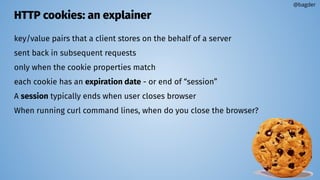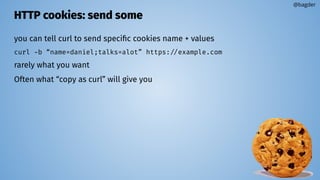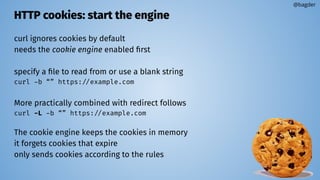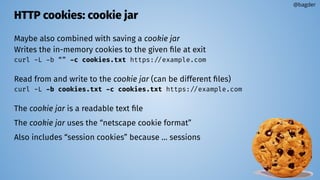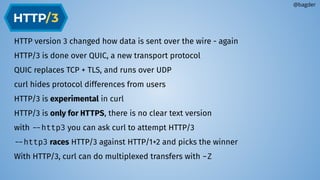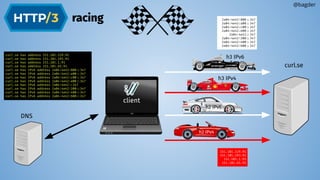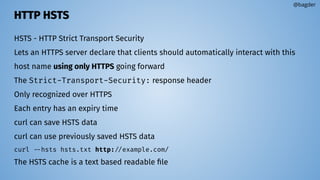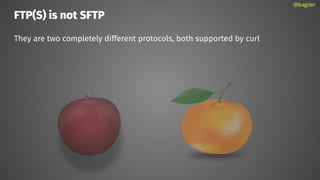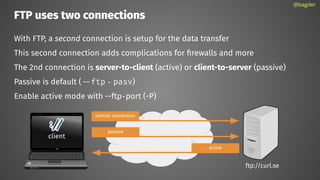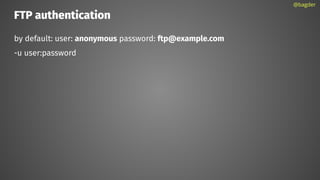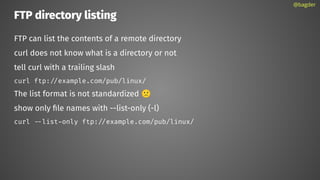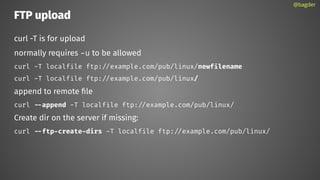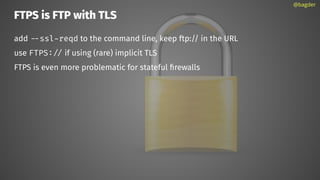The document provides a comprehensive overview of the 'curl' command line tool for internet transfers, detailing its history, development process, and command functionalities. It emphasizes the open-source nature of curl, its extensive compatibility with various protocols, and the methods for executing internet transfers such as uploads and downloads. Additionally, it includes instructions on using command line options, managing URLs, and accessing help resources.











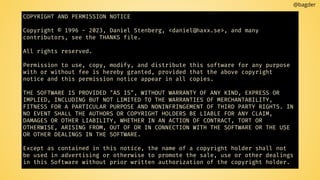
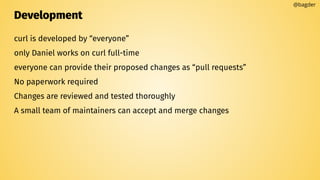

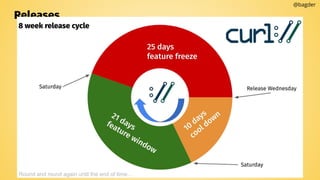





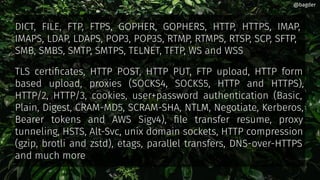








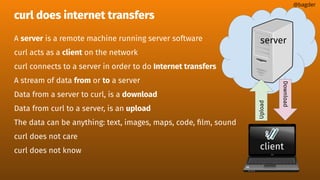

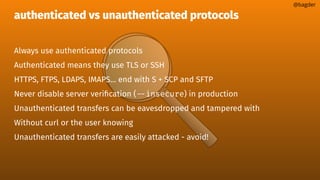

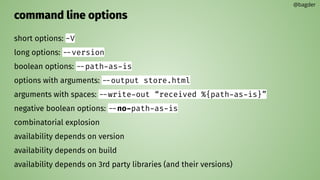

![URLs by RFC 3986
scheme://user:password@host:1234/path?query#fragment
@bagder
RFC 3986+ really
no spaces, use %20
“schemeless” means guess
name and password - remember URL encode
hostname can be name, IDN name, IPv4 address or IPv6 address
https://example.com/
http://日本語.tw
ftp://192.168.0.1/
imap://[2a04:4e42:800::347]/](https://image.slidesharecdn.com/masteringthecurlcommandline-230901071534-bfa3d756/85/mastering-the-curl-command-line-pdf-36-320.jpg)

![URL port numbers
A port number is from 0 to 65535
Each URL scheme has a default port that curl uses
Unless another is set in the URL
curl https://example.com:8080/
curl tftp://[fdea::1]:8080/
@bagder](https://image.slidesharecdn.com/masteringthecurlcommandline-230901071534-bfa3d756/85/mastering-the-curl-command-line-pdf-38-320.jpg)

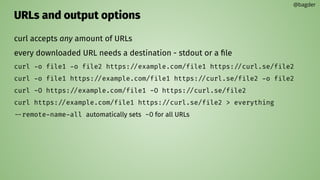
![query
Queries are often name=value pairs separated by amperands (&)
name=daniel & tool=curl & age=old
Add query parts to the URL with --url-query [content]
content is (for example) “name=value”
“value” gets URL encoded to keep the URL fine
name@file reads the content from file before encoding it
… and more
curl https://example.com --url-query “name=Daniel Stenberg”
@bagder
scheme://user:password@host:1234/path?query#fragment](https://image.slidesharecdn.com/masteringthecurlcommandline-230901071534-bfa3d756/85/mastering-the-curl-command-line-pdf-41-320.jpg)

![URL globbing
“globbing” = ranges and lists
[1-100]
[001-100]
[a-z]
[001-100:10]
[a-z:2]
{one,two,three}
{mon,tue,wed,thu}
$ curl https://{ftp,www,test}.example.com/img[1-22].jpg -o
“hey_#2_#1.jpg”
Can do 9 * 1018
iterations - per URL
--globoff turns it off
@bagder](https://image.slidesharecdn.com/masteringthecurlcommandline-230901071534-bfa3d756/85/mastering-the-curl-command-line-pdf-43-320.jpg)
![Parallel transfers
by default, URLs are transferred serially, one by one
-Z (--parallel)
By default up to 50 simultaneous
Change with --parallel‐max [num]
Prefer speed to multiplexing with --parallel‐immediate
Works for downloads and uploads
@bagder
server
client
Upload
Download](https://image.slidesharecdn.com/masteringthecurlcommandline-230901071534-bfa3d756/85/mastering-the-curl-command-line-pdf-44-320.jpg)
![list curl options
--help
--help [category]
--help category
--help all
curl --manual
@bagder](https://image.slidesharecdn.com/masteringthecurlcommandline-230901071534-bfa3d756/85/mastering-the-curl-command-line-pdf-45-320.jpg)
![config file
“command lines in a file”
one option (plus argument) per line
$HOME/.curlrc is used by default
-K [file] or --config [file]
can be read from stdin
can be generated (and huge)
10MB line length limit
@bagder](https://image.slidesharecdn.com/masteringthecurlcommandline-230901071534-bfa3d756/85/mastering-the-curl-command-line-pdf-46-320.jpg)

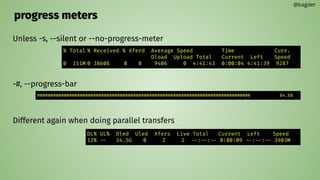
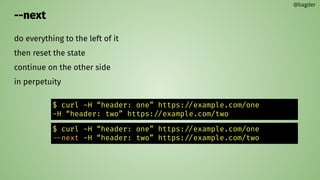

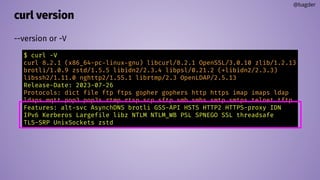

![trace
@bagder
$ curl -d moo --trace - https://curl.se/
== Info: processing: https://curl.se/
== Info: Trying [2a04:4e42:e00::347]:443...
== Info: Connected to curl.se (2a04:4e42:e00::347) port 443
== Info: ALPN: offers h2,http/1.1
=> Send SSL data, 5 bytes (0x5)
0000: 16 03 01 02 00 .....
== Info: TLSv1.3 (OUT), TLS handshake, Client hello (1):
=> Send SSL data, 512 bytes (0x200)
0000: 01 00 01 fc 03 03 82 d6 6e 54 af be fa d7 91 c1 ........nT......
0010: 92 0a 4e bf dc f7 39 a4 53 4d ee 22 18 bc c1 86 ..N...9.SM."....
0020: 92 96 9a a1 73 88 20 ee 52 63 66 65 8d 06 45 df ....s. .Rcfe..E.
…
== Info: CAfile: /etc/ssl/certs/ca-certificates.crt
== Info: CApath: /etc/ssl/certs
<= Recv SSL data, 5 bytes (0x5)
0000: 16 03 03 00 7a ....z
== Info: TLSv1.3 (IN), TLS handshake, Server hello (2):
<= Recv SSL data, 122 bytes (0x7a)
0000: 02 00 00 76 03 03 59 27 14 18 87 2b ec 23 19 ab ...v..Y'...+.#..
0010: 30 a0 f5 e0 97 30 89 27 44 85 c1 0a c9 d0 9d 74 0....0.'D......t
…
== Info: SSL connection using TLSv1.3 / TLS_AES_256_GCM_SHA384
== Info: ALPN: server accepted h2
== Info: Server certificate:
== Info: subject: CN=curl.se
== Info: start date: Jun 22 08:07:48 2023 GMT
== Info: expire date: Sep 20 08:07:47 2023 GMT
== Info: subjectAltName: host "curl.se" matched cert's "curl.se"
== Info: issuer: C=US; O=Let's Encrypt; CN=R3
== Info: SSL certificate verify ok.
…
== Info: using HTTP/2
== Info: h2 [:method: POST]
== Info: h2 [:scheme: https]
== Info: h2 [:authority: curl.se]
== Info: h2 [:path: /]
== Info: h2 [user-agent: curl/8.2.1]
== Info: h2 [accept: */*]
== Info: h2 [content-length: 3]
== Info: h2 [content-type: application/x-www-form-urlencoded]
== Info: Using Stream ID: 1
=> Send SSL data, 5 bytes (0x5)
0000: 17 03 03 00 5d ....]
=> Send SSL data, 1 bytes (0x1)
0000: 17 .
=> Send header, 137 bytes (0x89)
0000: 50 4f 53 54 20 2f 20 48 54 54 50 2f 32 0d 0a 48 POST / HTTP/2..H
0010: 6f 73 74 3a 20 63 75 72 6c 2e 73 65 0d 0a 55 73 ost: curl.se..Us
0020: 65 72 2d 41 67 65 6e 74 3a 20 63 75 72 6c 2f 38 er-Agent: curl/8
0030: 2e 32 2e 31 0d 0a 41 63 63 65 70 74 3a 20 2a 2f .2.1..Accept: */
0040: 2a 0d 0a 43 6f 6e 74 65 6e 74 2d 4c 65 6e 67 74 *..Content-Lengt
0050: 68 3a 20 33 0d 0a 43 6f 6e 74 65 6e 74 2d 54 79 h: 3..Content-Ty
0060: 70 65 3a 20 61 70 70 6c 69 63 61 74 69 6f 6e 2f pe: application/
0070: 78 2d 77 77 77 2d 66 6f 72 6d 2d 75 72 6c 65 6e x-www-form-urlen
0080: 63 6f 64 65 64 0d 0a 0d 0a coded....
=> Send data, 3 bytes (0x3)
0000: 6d 6f 6f moo
…
<= Recv header, 13 bytes (0xd)
0000: 48 54 54 50 2f 32 20 32 30 30 20 0d 0a HTTP/2 200 ..
<= Recv header, 22 bytes (0x16)
0000: 73 65 72 76 65 72 3a 20 6e 67 69 6e 78 2f 31 2e server: nginx/1.
0010: 32 31 2e 31 0d 0a 21.1..
<= Recv header, 25 bytes (0x19)
0000: 63 6f 6e 74 65 6e 74 2d 74 79 70 65 3a 20 74 65 content-type: te
0010: 78 74 2f 68 74 6d 6c 0d 0a xt/html..
<= Recv header, 29 bytes (0x1d)
0000: 78 2d 66 72 61 6d 65 2d 6f 70 74 69 6f 6e 73 3a x-frame-options:
0010: 20 53 41 4d 45 4f 52 49 47 49 4e 0d 0a SAMEORIGIN..
<= Recv header, 46 bytes (0x2e)
0000: 6c 61 73 74 2d 6d 6f 64 69 66 69 65 64 3a 20 54 last-modified: T
0010: 68 75 2c 20 31 30 20 41 75 67 20 32 30 32 33 20 hu, 10 Aug 2023
0020: 30 32 3a 30 35 3a 30 33 20 47 4d 54 0d 0a 02:05:03 GMT..
<= Recv header, 28 bytes (0x1c)
0000: 65 74 61 67 3a 20 22 32 30 64 39 2d 36 30 32 38 etag: "20d9-6028
0010: 38 30 36 33 33 31 35 34 64 22 0d 0a 80633154d"..
<= Recv header, 22 bytes (0x16)
0000: 61 63 63 65 70 74 2d 72 61 6e 67 65 73 3a 20 62 accept-ranges: b
0010: 79 74 65 73 0d 0a ytes..
<= Recv header, 27 bytes (0x1b)
0000: 63 61 63 68 65 2d 63 6f 6e 74 72 6f 6c 3a 20 6d cache-control: m
0010: 61 78 2d 61 67 65 3d 36 30 0d 0a ax-age=60..
<= Recv header, 40 bytes (0x28)
0000: 65 78 70 69 72 65 73 3a 20 54 68 75 2c 20 31 30 expires: Thu, 10
0010: 20 41 75 67 20 32 30 32 33 20 30 37 3a 30 36 3a Aug 2023 07:06:
0020: 31 34 20 47 4d 54 0d 0a 14 GMT..
…
…
<= Recv data, 867 bytes (0x363)
0000: 3c 21 44 4f 43 54 59 50 45 20 48 54 4d 4c 20 50 <!DOCTYPE HTML P
0010: 55 42 4c 49 43 20 22 2d 2f 2f 57 33 43 2f 2f 44 UBLIC "-//W3C//D
0020: 54 44 20 48 54 4d 4c 20 34 2e 30 31 20 54 72 61 TD HTML 4.01 Tra
0030: 6e 73 69 74 69 6f 6e 61 6c 2f 2f 45 4e 22 20 22 nsitional//EN" "
0040: 68 74 74 70 3a 2f 2f 77 77 77 2e 77 33 2e 6f 72 http://www.w3.or
0050: 67 2f 54 52 2f 68 74 6d 6c 34 2f 6c 6f 6f 73 65 g/TR/html4/loose
0060: 2e 64 74 64 22 3e 0a 3c 68 74 6d 6c 20 6c 61 6e .dtd">.<html lan
0070: 67 3d 22 65 6e 22 3e 0a 3c 68 65 61 64 3e 0a 3c g="en">.<head>.<
0080: 74 69 74 6c 65 3e 63 75 72 6c 3c 2f 74 69 74 6c title>curl</titl
0090: 65 3e 0a 3c 6d 65 74 61 20 6e 61 6d 65 3d 22 76 e>.<meta name="v
00a0: 69 65 77 70 6f 72 74 22 20 63 6f 6e 74 65 6e 74 iewport" content
00b0: 3d 22 77 69 64 74 68 3d 64 65 76 69 63 65 2d 77 ="width=device-w
00c0: 69 64 74 68 2c 20 69 6e 69 74 69 61 6c 2d 73 63 idth, initial-sc
00d0: 61 6c 65 3d 31 2e 30 22 3e 0a 3c 6d 65 74 61 20 ale=1.0">.<meta
00e0: 63 6f 6e 74 65 6e 74 3d 22 74 65 78 74 2f 68 74 content="text/ht
00f0: 6d 6c 3b 20 63 68 61 72 73 65 74 3d 55 54 46 2d ml; charset=UTF-
0100: 38 22 20 68 74 74 70 2d 65 71 75 69 76 3d 22 43 8" http-equiv="C
0110: 6f 6e 74 65 6e 74 2d 54 79 70 65 22 3e 0a 3c 6c ontent-Type">.<l
0120: 69 6e 6b 20 72 65 6c 3d 22 73 74 79 6c 65 73 68 ink rel="stylesh
curl -d moo --trace - https://curl.se/](https://image.slidesharecdn.com/masteringthecurlcommandline-230901071534-bfa3d756/85/mastering-the-curl-command-line-pdf-53-320.jpg)
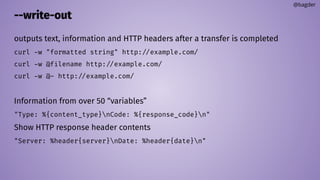

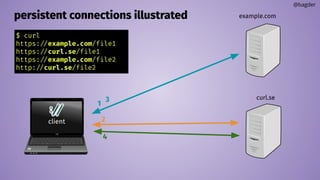
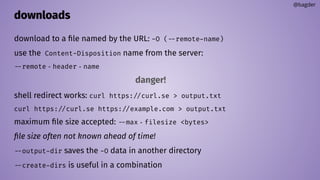
![retry
If a transient error is returned when curl tries to perform a transfer
Do a few retries: --retry [num]
Retry for this long: --retry‐max‐time <seconds>
Wait this long between retries: --retry‐delay <seconds>
Consider “connection refused” to be transient: --retry‐connrefused
Consider all errors transient: --retry‐all-errors
@bagder](https://image.slidesharecdn.com/masteringthecurlcommandline-230901071534-bfa3d756/85/mastering-the-curl-command-line-pdf-58-320.jpg)
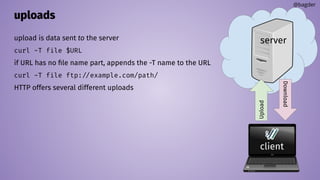
![transfer controls
stop slow transfers
--speed‐limit <speed> --speed‐time <seconds>
transfer rate limiting
curl --limit-rate 100K https://example.com
no more than this number of transfer starts per time unit
curl --rate 2/s https://example.com/[1-20].jpg
curl --rate 3/h https://example.com/[1-20].html
curl --rate 14/m https://example.com/day/[1-365]/fun.html
@bagder](https://image.slidesharecdn.com/masteringthecurlcommandline-230901071534-bfa3d756/85/mastering-the-curl-command-line-pdf-60-320.jpg)
![naming tricks
Provide a name + port => address mapping
curl --resolve example.com:443:127.0.0.1 https://example.com/
curl --resolve example.com:80:[2a04:4e42:200::347] http://example.com/
Provide a name + port => name + port mapping
curl --connect-to example.com:80:curl.se:8080 http://example.com/
Talking HTTP, it is also sometimes fun/useful to set Host: header:
curl -H “host: curl.fake” http://example.com/
When TLS is used, this might fail certificate checks
@bagder](https://image.slidesharecdn.com/masteringthecurlcommandline-230901071534-bfa3d756/85/mastering-the-curl-command-line-pdf-61-320.jpg)
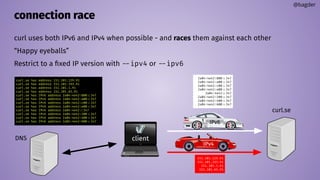
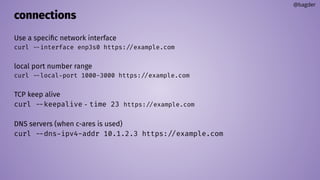
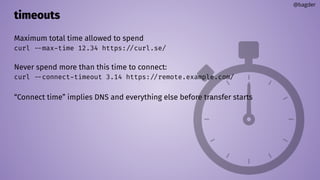
![.netrc
a file for users to store their credentials for remote FTP servers
$HOME/.netrc
since 1978
--netrc makes curl use it
--netrc‐file [file] to use another file
for all protocols
beware: weakly specified
$ cat $HOME/.netrc
machine example.com
login daniel
password qwerty
@bagder](https://image.slidesharecdn.com/masteringthecurlcommandline-230901071534-bfa3d756/85/mastering-the-curl-command-line-pdf-65-320.jpg)
![exit status
the numerical value curl returns back to the shell/prompt
zero for success
conveys the reason for errors
can be tested for in shell scripts
#!/bin/sh
curl https://example.com/page.html -O
res=$?
if [ $res -ne 0 ]; then
echo “curl command failed with $res”
fi
@bagder
$ curl -o save https://example.com/
…
curl: (23) Failure writing output to destination
$ echo $?
23](https://image.slidesharecdn.com/masteringthecurlcommandline-230901071534-bfa3d756/85/mastering-the-curl-command-line-pdf-66-320.jpg)

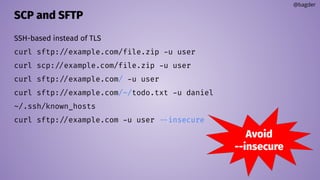
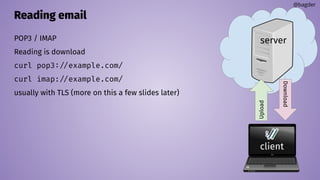
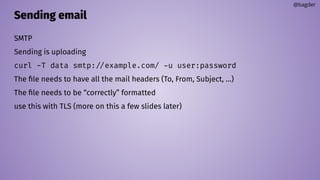

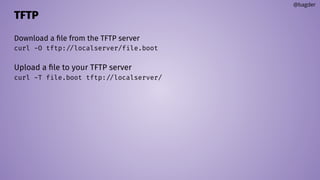









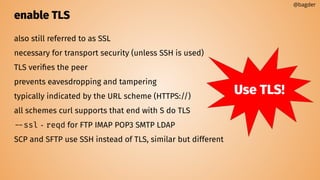
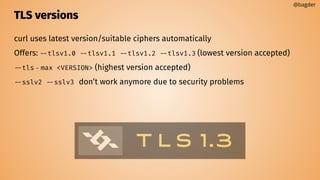


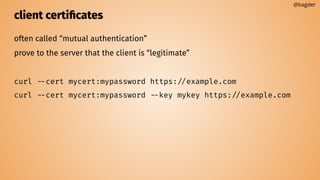
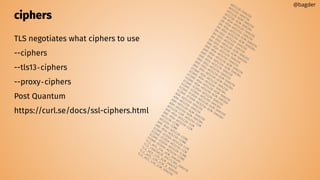
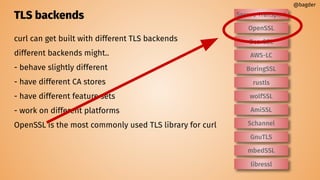
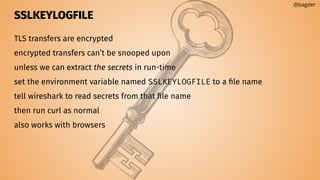
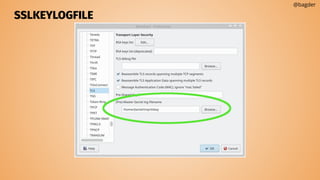
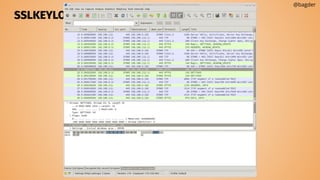

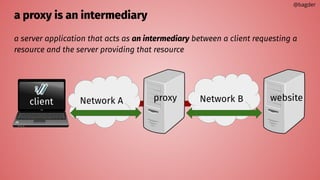


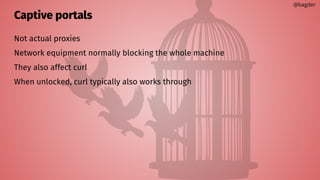
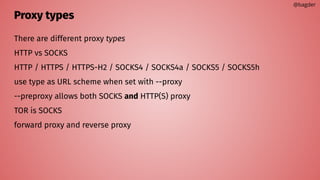
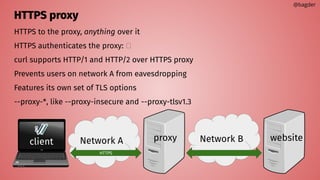
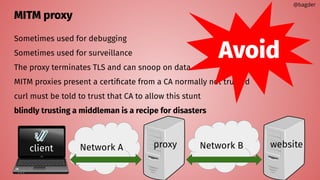

![Proxy environment variables
[scheme]_proxy
curl https://example.com/ HTTPS_PROXY
curl ftp://example.com/ FTP_PROXY
curl http://example.com/ http_proxy
ALL_PROXY
NO_PROXY
@bagder](https://image.slidesharecdn.com/masteringthecurlcommandline-230901071534-bfa3d756/85/mastering-the-curl-command-line-pdf-101-320.jpg)


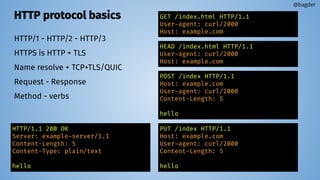
![HTTP Method
Sometimes called “verb”
GET
HEAD (-I)
POST (-d or -F)
PUT (-T)
anything
methods are sometimes abused
-X [whatever]
Avoid -X
@bagder](https://image.slidesharecdn.com/masteringthecurlcommandline-230901071534-bfa3d756/85/mastering-the-curl-command-line-pdf-105-320.jpg)
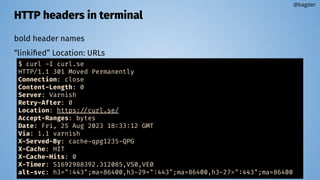

![HTTP response headers
-v or -I to see them
or -i
describes the body or the transfer
save them with -D [filename]
looks like HTTP/1 even when other HTTP versions are used
HTTP/1.1 200 OK
Server: example-server/1.1
Content-Length: 5
Content-Type: plain/text
hello
@bagder](https://image.slidesharecdn.com/masteringthecurlcommandline-230901071534-bfa3d756/85/mastering-the-curl-command-line-pdf-108-320.jpg)
![HTTP response bodies
The “payload”
Content-Length
HTTP/1.1 chunked-encoding
HTTP/2 and HTTP/3 have distinct end of data markers
--compressed
store to file with -o [file] or -O
HTTP/1.1 200 OK
Server: example-server/1.1
Content-Length: 5
Content-Type: plain/text
hello
@bagder](https://image.slidesharecdn.com/masteringthecurlcommandline-230901071534-bfa3d756/85/mastering-the-curl-command-line-pdf-109-320.jpg)
![HTTP authentication
web logins are often done with cookies, we get to those later
if HTTP based, returns 401 for server auth needed
returns 407 for proxy auth
WWW-Authenticate:
Basic, Digest, NTLM, Negotiate, etc
-u [user]:[password]
--anyauth
--basic, --digest, --ntlm, --negotiate
@bagder](https://image.slidesharecdn.com/masteringthecurlcommandline-230901071534-bfa3d756/85/mastering-the-curl-command-line-pdf-110-320.jpg)
![HTTP ranges
Ask for a piece of a remote resource
curl --range 500-999 https://example.com/file.txt
server may ignore the ask
curl’s -C [where] resumes the transfer at that index
@bagder](https://image.slidesharecdn.com/masteringthecurlcommandline-230901071534-bfa3d756/85/mastering-the-curl-command-line-pdf-111-320.jpg)
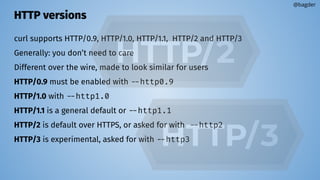
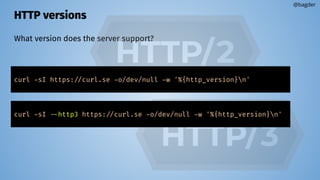
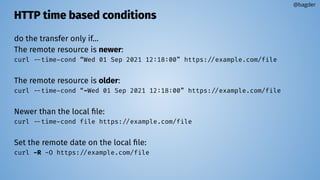
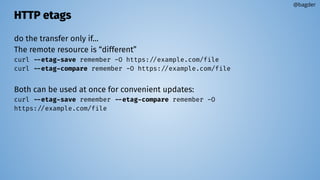
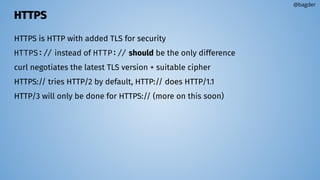
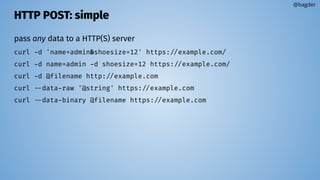
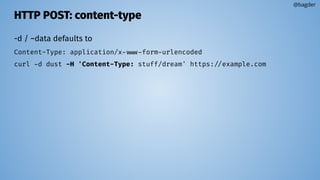
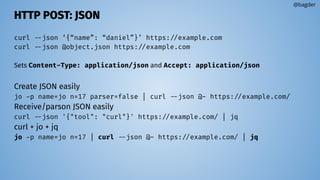
![HTTP POST: URL encoding
--data-urlencode helps URL encode data to send
curl --data-urlencode "name=John Doe (Junior)" http://example.com
sends name=John%20Doe%20%28Junior%29
-data-urlencode [content] where content is…
anything URL encode the content
=anything URL encode the content (leave out the ‘=’)
any=thing Send as “any=[URL encoded thing]”
@anything Read content from file, URL encode and use
any@thing Send as “any=[URL encoded file contents]”
@bagder](https://image.slidesharecdn.com/masteringthecurlcommandline-230901071534-bfa3d756/85/mastering-the-curl-command-line-pdf-120-320.jpg)
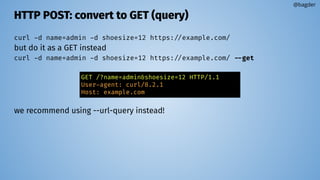
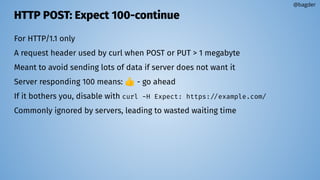
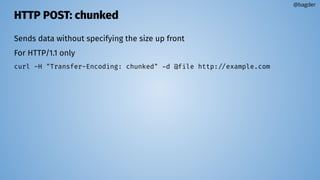
![HTTP POST: <form>
The HTML <form> tag is “filled in” with a POST
type=hidden fields as well
-d name1=var1 -d name2=var2 -d name3=var3 …
The action=[here] identifies where to send the POST
“Copy as curl” is your friend
@bagder](https://image.slidesharecdn.com/masteringthecurlcommandline-230901071534-bfa3d756/85/mastering-the-curl-command-line-pdf-124-320.jpg)

![HTTP multipart formpost
curl -F [content] adds one part per instance
Use as many -F as you like
Insert plain text content -F “name=Daniel Stenberg”
Insert content from a file -F name=<file.txt
Insert a file as an “upload” -F name=@file.jpg
Insert a file, different file name -F name=@file.jpg;filename=fake.jpg
Set a custom content-type: -F name=@file.jpg;type=image/myown
<form action="submit" method="post" enctype="multipart/form-data">
@bagder](https://image.slidesharecdn.com/masteringthecurlcommandline-230901071534-bfa3d756/85/mastering-the-curl-command-line-pdf-126-320.jpg)

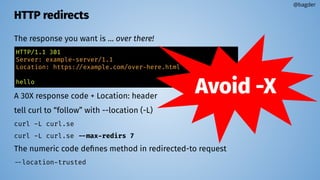

![HTTP modify the request
The request “target” is made from the URL path + query
GET /user/profile?shoesize=12 HTTP/1.1
User-agent: curl/8.2.1
Host: example.com
curl -X OPTIONS --request-target "*" http://example.com/
Convenient shortcuts:
--user-agent [string]
--referer [URL] (yes spelled wrong)
Remember “copy as curl”
@bagder](https://image.slidesharecdn.com/masteringthecurlcommandline-230901071534-bfa3d756/85/mastering-the-curl-command-line-pdf-130-320.jpg)
![HTTP PUT
The “upload file” of HTTP (and others)
curl -T localfile https://example.com/destination/replacement
curl -T - https://example.com/destination/replacement
curl -T file https://example.com
curl -T "img[1-1000].png" http://example.com/images/
curl --upload-file "{file1,file2}" https://example.com
curl -d "data to PUT" -X PUT http://example.com/new/resource/file
@bagder](https://image.slidesharecdn.com/masteringthecurlcommandline-230901071534-bfa3d756/85/mastering-the-curl-command-line-pdf-131-320.jpg)
